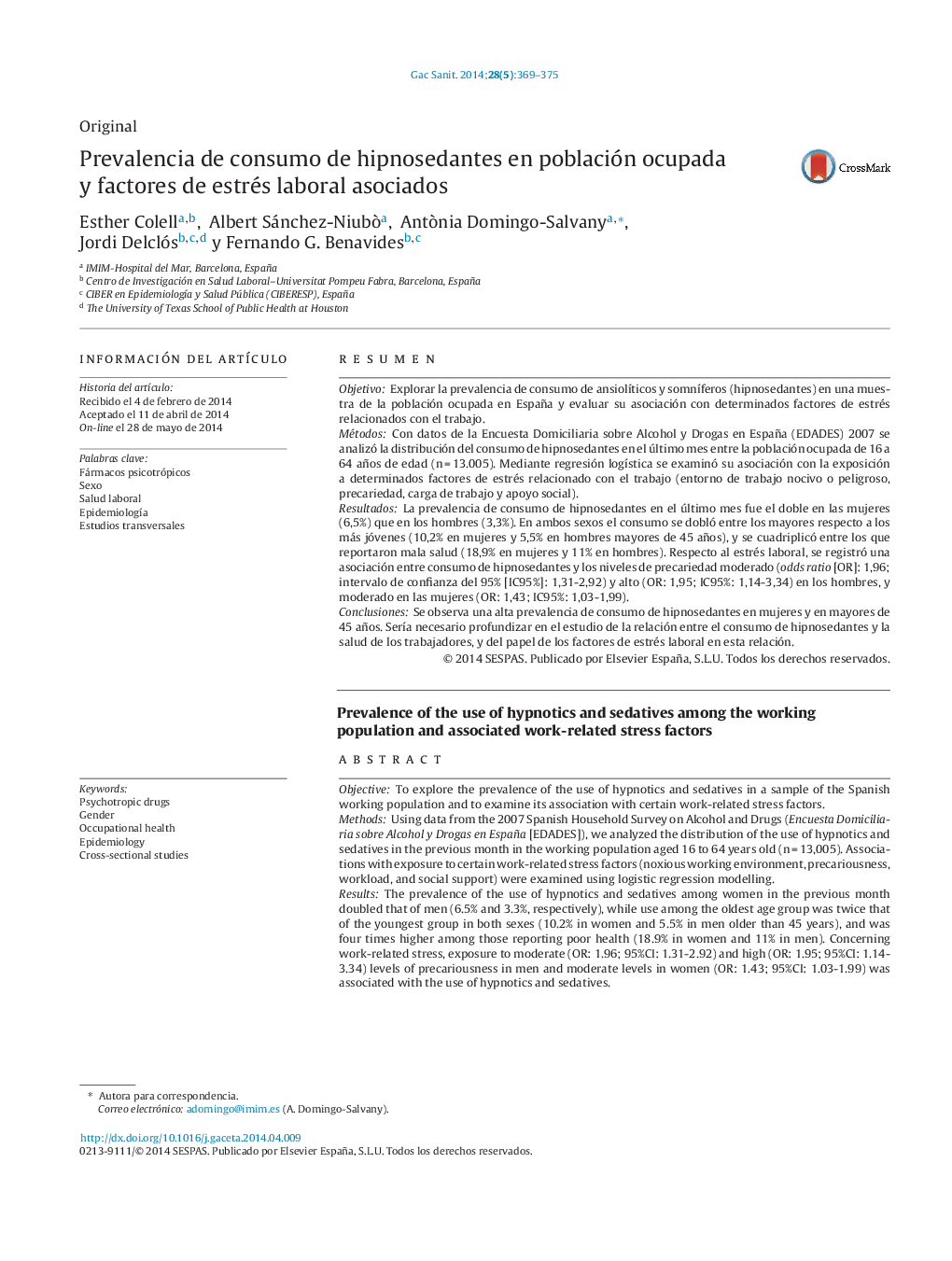| کد مقاله | کد نشریه | سال انتشار | مقاله انگلیسی | نسخه تمام متن |
|---|---|---|---|---|
| 1073498 | 949789 | 2014 | 7 صفحه PDF | دانلود رایگان |

ResumenObjetivoExplorar la prevalencia de consumo de ansiolíticos y somníferos (hipnosedantes) en una muestra de la población ocupada en España y evaluar su asociación con determinados factores de estrés relacionados con el trabajo.MétodosCon datos de la Encuesta Domiciliaria sobre Alcohol y Drogas en España (EDADES) 2007 se analizó la distribución del consumo de hipnosedantes en el último mes entre la población ocupada de 16 a 64 años de edad (n = 13.005). Mediante regresión logística se examinó su asociación con la exposición a determinados factores de estrés relacionado con el trabajo (entorno de trabajo nocivo o peligroso, precariedad, carga de trabajo y apoyo social).ResultadosLa prevalencia de consumo de hipnosedantes en el último mes fue el doble en las mujeres (6,5%) que en los hombres (3,3%). En ambos sexos el consumo se dobló entre los mayores respecto a los más jóvenes (10,2% en mujeres y 5,5% en hombres mayores de 45 años), y se cuadriplicó entre los que reportaron mala salud (18,9% en mujeres y 11% en hombres). Respecto al estrés laboral, se registró una asociación entre consumo de hipnosedantes y los niveles de precariedad moderado (odds ratio [OR]: 1,96; intervalo de confianza del 95% [IC95%]: 1,31-2,92) y alto (OR: 1,95; IC95%: 1,14-3,34) en los hombres, y moderado en las mujeres (OR: 1,43; IC95%: 1,03-1,99).ConclusionesSe observa una alta prevalencia de consumo de hipnosedantes en mujeres y en mayores de 45 años. Sería necesario profundizar en el estudio de la relación entre el consumo de hipnosedantes y la salud de los trabajadores, y del papel de los factores de estrés laboral en esta relación.
ObjectiveTo explore the prevalence of the use of hypnotics and sedatives in a sample of the Spanish working population and to examine its association with certain work-related stress factors.MethodsUsing data from the 2007 Spanish Household Survey on Alcohol and Drugs (Encuesta Domiciliaria sobre Alcohol y Drogas en España [EDADES]), we analyzed the distribution of the use of hypnotics and sedatives in the previous month in the working population aged 16 to 64 years old (n = 13,005). Associations with exposure to certain work-related stress factors (noxious working environment, precariousness, workload, and social support) were examined using logistic regression modelling.ResultsThe prevalence of the use of hypnotics and sedatives among women in the previous month doubled that of men (6.5% and 3.3%, respectively), while use among the oldest age group was twice that of the youngest group in both sexes (10.2% in women and 5.5% in men older than 45 years), and was four times higher among those reporting poor health (18.9% in women and 11% in men). Concerning work-related stress, exposure to moderate (OR: 1.96; 95%CI: 1.31-2.92) and high (OR: 1.95; 95%CI: 1.14-3.34) levels of precariousness in men and moderate levels in women (OR: 1.43; 95%CI: 1.03-1.99) was associated with the use of hypnotics and sedatives.ConclusionsThe prevalence of the use of hypnotics and sedatives was high in women and in workers older than 45 years. Further research is needed on the relationship between the use of hypnotics and sedatives and workers’ health, and on the role that work-related stress factors play in this association.
Journal: Gaceta Sanitaria - Volume 28, Issue 5, September–October 2014, Pages 369–375